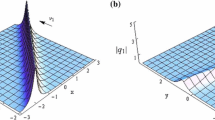Abstract
Based on the method of Hirota’s bilinear derivative transform, the derivative nonlinear Schrödinger equation with vanishing boundary condition has been directly solved. The one- and two-soliton solutions are given as two typical examples in the illustration of the general procedures and the concrete cut-off technique of the series-form solution, and the n-soliton solution is also attained by induction method. Our study shows their equivalence to the existing soliton solutions by a simple parameter transformation. The methodological importance of bilinear derivative transform in dealing with an integrable nonlinear equation has also been emphasized. The evolution of one and two-soliton solution with respect to time and space has been discussed in detail. The collision among the solitons has been manifested through an example of two-soliton case, revealing the elastic essence of the collision and the invariance of the soliton form and characteristics.
Similar content being viewed by others
References
Rogister A. Parallel Propagation of Nonlinear Low-Frequency Waves in High-β Plasma [J]. Phys Fluids, 1971: 14, 2733.
Ruderman M S. DNLS Equation for Large-Amplitude Solitons Propagating in an Arbitrary Direction in a High-β Hall Plasma [J]. J Plasma Phys, 2002, 67: 271.
Hada T, Matsumoto T. Nonlinear Waves and Chaos in Space Plasmas[M]. Tokyo: Terra Scientific Publishing Company, 1997.
Tzoar N, Jain M. Self-Phase Modulation in Long-Geometry Optical Waveguides[J]. Phys Rev A, 1981, 23: 1266.
Anderson D, Lisak M. Nonlinear Asymmetric Self-Phase Modulation and Self-Steepening of Pulses in Long Optical Waveguides [J]. Phys Rev A, 1983, 27: 1393.
Govind P A. Nonlinear Fiber Optics[M]. 3rd Ed. New York: Academic Press, 2001.
Nakata I. Weak Nonlinear Electromagnetic Waves in a Ferromagnet Propagating Parallel to an External Magnetic Field[J]. Phys Soc Jpn, 1991, 60(11): 3976.
Nakata I, Ono H, Yosida M. Solitons in a Dielectric Medium under an External Magnetic Field [J]. Prog Theor Phys, 1993, 90(3): 739.
Daniel M, Veerakumar V. Propagation of Electromagnetic Soliton in Anti-Ferromagnetic Medium[J]. Phys Lett A, 2002, 302: 77–86.
Kaup D J, Newell A C. Solitons as Particles, Oscillators, and in Slowly Changing Media: A Singular Perturbation Theory[J]. Proceedings of the Royal Society of London, series A, 1978, 361: 413.
Kaup D J, Newell A C. An Exact Solution for a Derivative Nonlinear Schrödinger Equation [J]. Journal of Mathematical Physics, 1978, 19: 798.
Wadati M, Konno K, Ichikawa Y H. A Generalization of Inverse Scattering Method [J]. J Phys Soc Japan, 1979, 46: 1965.
Nakamura A, Chen H H. Multi-Soliton Solutions of Derivative Nonlinear Schrödinger Equation [J]. J Phys Soc Japan, 1980, 49: 813.
Huang N N, Chen Z Y. Alfven Solitons[J]. J Phys A: Math Gen, 1990, 23: 439.
Steudel H. The Hierarchy of Multi-Soliton Solutions of Derivative Nonlinear Schrödinger Equation[J]. J Phys A, 2003, 36: 1931.
Zhou G Q, Huang N N. An N-Soliton Solution to the DNLS Equation Based on Revised Inverse Scattering Transform[J]. J Phys A, 2007, 40: 13607–13623.
Hirota R. The Direct Method in Soliton Theory[M]. Cambridge: Cambridge University Press, 2004.
Huang Nianning. Theory of Solitons and Method of Perturbations[M]. Shanghai: Shanghai Scientific and Technological Education Publishing House, 1996(Ch).
Author information
Authors and Affiliations
Corresponding author
Additional information
Foundation item: Supported by the National Natural Science Foundation of China (10775105)
Biography: ZHOU Guoquan(1965–), male, Associate professor, Ph.D., research direction: nonlinear integrable equations and field theory.
Rights and permissions
About this article
Cite this article
Zhou, G., Bi, X. Soliton solution of the DNLS equation based on Hirota’s bilinear derivative transform. Wuhan Univ. J. Nat. Sci. 14, 505–510 (2009). https://doi.org/10.1007/s11859-009-0609-7
Received:
Published:
Issue Date:
DOI: https://doi.org/10.1007/s11859-009-0609-7
Key words
- soliton
- nonlinear equation
- derivative nonlinear Schrödinger equation
- Hirota’s method
- bilinear derivative transform




